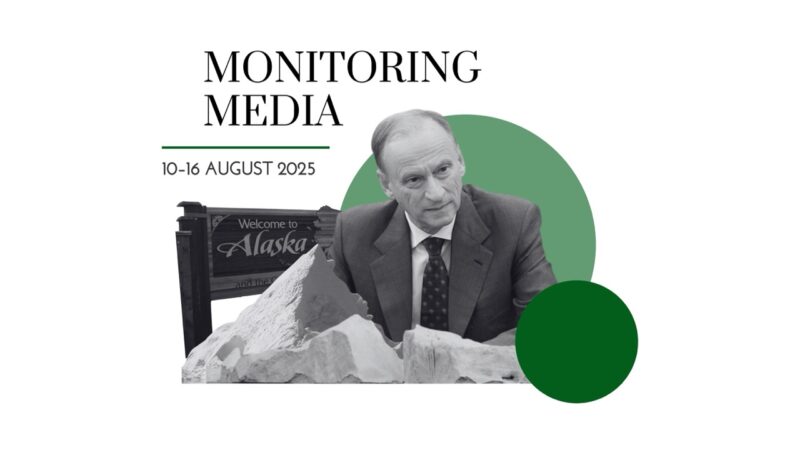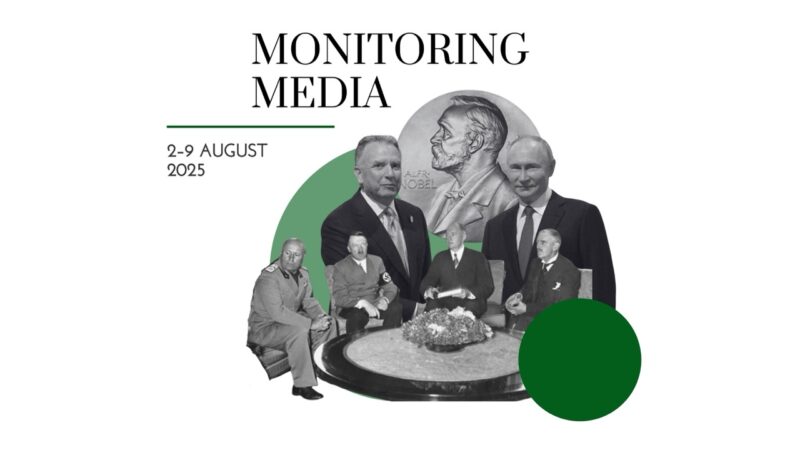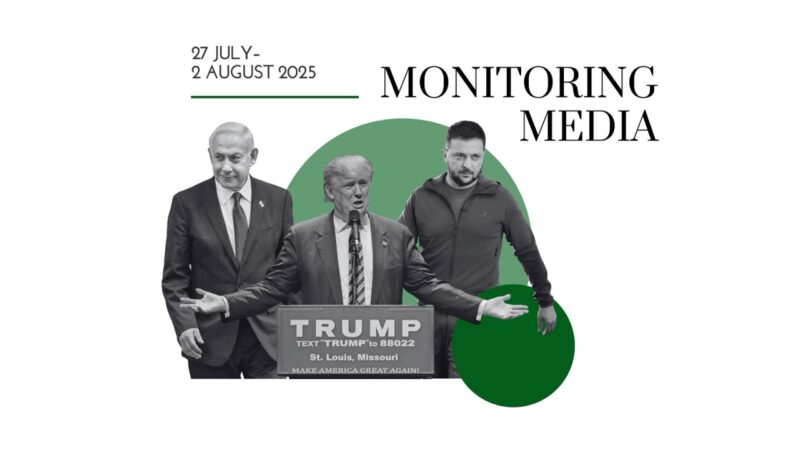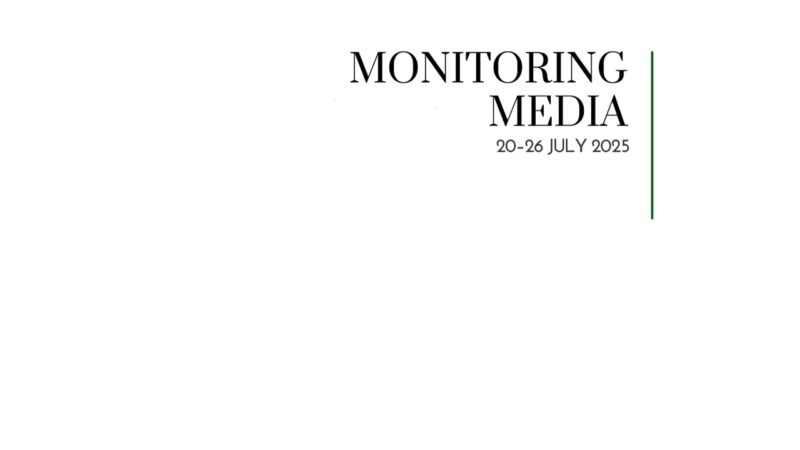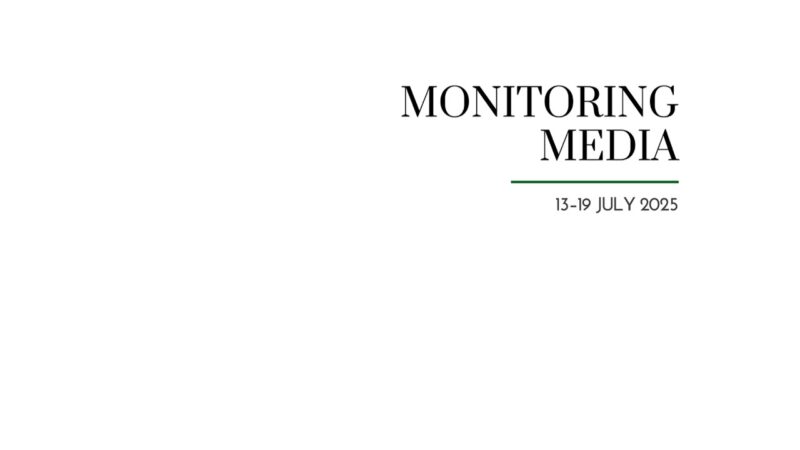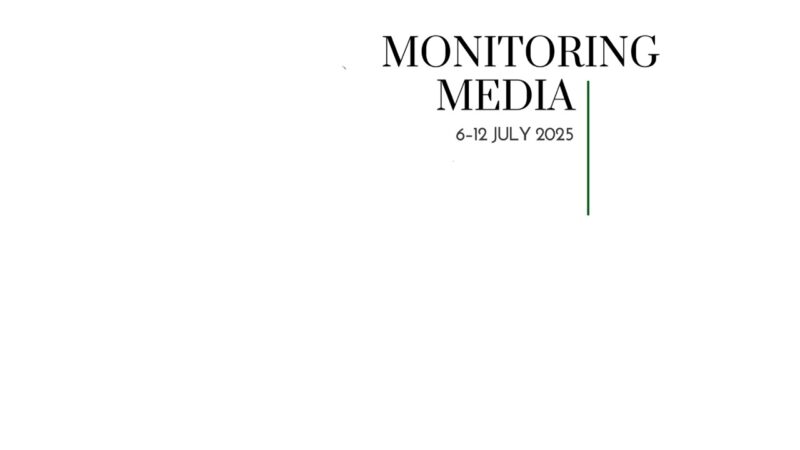Russian cruelty in Ukraine’s occupied territories is beyond imagination

CIUS weekly report on North American media coverage of Ukrainian affairs, 11–17 February 2023
Three publications (Atlantic Council, The Atlantic, and The National Interest) were selected to prepare this report on how the situation in Ukraine has been portrayed in the North American press during the past week (11–17 February 2023). The sample was compiled based on their impact on public opinion as well as on their professional reputation, popularity among the readership, and topical relevance. These three publications represent centrist and conservative viewpoints on the political spectrum.
This report covers only the most-read and relevant articles about Ukraine, as ranked by the respective North American publications themselves in the past week. Its scope covers promoted articles on home pages and articles from special sections on Ukraine, with the hashtag #Ukraine, from the paper editions of the publications, and about Ukraine from opinion columns and editorials.
Topics featured in the selected articles:
- Ukraine’s current affairs: Ukraine’s modern high-tech warfare may be sufficient to offset the sheer numbers of Russia’s recent mobilization; Ukraine’s private enterprise sector expected to lead the post-war reconstruction and help curtail corruption; Ukrainian-Russian relations will never again be as close as they were in the 2000s;
- The world and Ukraine: ECHR rules that Russia invaded Ukraine already in 2014; the West should not be afraid to overstep Russia’s “red lines,” as it has little to retaliate with;
- Russia at war: historically Russia has never been as victorious as it claims; Russia’s forthcoming offensive may lead to a collapse of its army; Russians continue to commit atrocities in the occupied territories; Moscow’s accusations of Ukraine assembling a “dirty” nuclear bomb are a bluff.
Main arguments:
Ukraine should not overestimate the threat coming from Russia’s deployment of more soldiers. Gil Barndollar (The Atlantic) writes that Russia gained a numerical superiority after mobilizing 300,000 soldiers; however, that is not a recipe for victory in modern war: “Ukraine’s Western backers should hold their nerve and keep providing Ukraine with what it needs most: modern weapons and the training to use them effectively.” According to Barndollar, the recently mobilized Russian soldiers are former one-year conscripts, who had not received any special training in at least five years. They were hastily equipped with old weaponry, have suffered great casualties on the battlefield, and are the first to lose their fighting spirit. Without exaggerating the threat, Ukraine should continue to utilize its superior ability in both employing and evading firepower—these have proved to be a crucial factor for effective warfare so far: “Modern firepower has ‘emptied’ the battlefield…Units have to disperse and seek cover and concealment from enemy observation and the fire that follows it. That has become only more emphatically the case on battlefields surveilled by satellites and growing drone fleets.” Barndollar argues that Russians are struggling to disperse and survive in the face of Ukraine’s surveillance and firing tactics today. The increased numbers of Russian soldiers—who are poorly disciplined, trained, and commanded—will likely only make them better targets. Unpreparedness for long-lasting, high-intensity, and high-tech war is nothing new in Russian history: the First World War was similar in many respects and led to imperial Russia’s defeat. Barndollar concludes with a statement by the 18th-century French philosopher Voltaire: “God is not on the side of the big battalions but on the side of those who shoot best.”
Ukraine’s private sector likely to be an essential component of the state’s postwar reconstruction. Suriya Evans-Pritchard Jayanti (Atlantic Council) argues that the private sector can help rebuild Ukraine after the fighting is over, particularly in the sphere of curtailing corruption. In recent weeks Western media have highlighted a number of damaging corruption allegations against senior government figures in Ukraine. Ministers, deputy ministers, and oblast governors came under scrutiny, and some of them resigned or were dismissed. Such a development in the time of war is very unfortunate because it erodes the credibility of Kyiv officials as responsible partners in the eyes of the West. The author observes that the problem of corruption in Ukraine did not resurface overnight. Media scandals and investigations have made a regular appearance since the state became independent. To mitigate this problem in the future, Evans-Pritchard Jayanti recommends working with the private sector more intensively: “Private companies seeking Western investment have to meet Western standards, requirements, and anti-corruption norms. Major international companies simply won’t invest unless they are comfortable that they are not exposing themselves to unnecessary risk, including the financial, criminal, and reputational risk of corruption scandals. Similarly, Ukrainian companies cannot reliably attract foreign investment unless they can demonstrate that these risks are at a minimum.” The author concludes that Ukraine should let “the private sector take the lead on national reconstruction.”
The breakdown in Ukrainian-Russian relations has crossed the point of no return. Taras Kuzio (Atlantic Council) opens his article with a statement that “after Mariupol, Bucha, and countless other Russian war crimes, there can be no more talk of a return to an earlier era of close ties and blurred borders.” When discussing the evolution in Ukrainian-Russian relations during the past three decades, Kuzio points to two major watersheds—the Orange Revolution of 2004 and the Euromaidan of 2014. The first made Vladimir Putin revise his perception of Ukraine and the West; feeling humiliated, he became more antagonistic. As a result, in the late 2010s Russian media began aggressively criticizing events and leaders in post-revolutionary Ukraine. The second watershed happened with the direct intervention of Russian troops in Ukraine and occupation of the Autonomous Republic of Crimea and parts of the Donbas. Russian-speaking Ukrainians who resided in these territories became major victims of the war, and their formerly positive attitudes toward the northeastern neighbour plummeted across the state. Finally, following the 2022 full-scale invasion and the atrocities it brought, “Ukrainians overwhelmingly express negative attitudes toward the Russian population and have been horrified to witness the popularity of the war among ordinary Russians.” Kuzio emphasizes that relations between the two nations have broken down and crossed a point of no return. Derussification is gaining momentum among Ukrainians, who are striving to remove imperial and Soviet legacies from their everyday lives (including domination of the Russian language in specific regions). Kuzio concludes that “many Russians remain in denial over the depth of the divide now separating them from their Ukrainian neighbors, preferring instead to blame everything on phantom fascists and meddling Westerners. This is wishful thinking. In reality, the two countries have never been further apart, and the seeds of hatred sown by Putin’s invasion will continue to define the bilateral relationship long after Russia is defeated.”
A major European court ruled that Russia started the war in Ukraine in 2014. Zakhar Tropin (Atlantic Council) writes about an important Ukrainian political victory over Russia, highlighting that the European Court for Human Rights (ECHR) “found that areas in eastern Ukraine in separatist hands were from May 11, 2014, and up to at least January 26, 2022, under the jurisdiction of the Russian Federation.” This means that one of the most authoritative European institutions defied the Kremlin’s narratives about the so-called right to self-determination of the people of Donbas, as well as confirmed that the first act of Russian military aggression against Ukraine in the current war had taken place in 2014 (not in 2022). “The recent ECHR decision will have potentially wide-ranging implications in this context. It now paves the way for a series of international cases that had been put on hold pending a ruling over jurisdiction.” One such case is Russia’s responsibility for the shooting down of the civilian flight MH17 over eastern Ukraine in 2014. In total, however, there have been more than 8,000 individual cases submitted to the ECHR against Russia in under nine years. Tropin also writes that while the ECHR decision marks a new stage in holding the invader accountable for attacking Ukraine, justice will not be served in the nearest future. Russia continues to commit war crimes and atrocities, the current government in the Kremlin does not recognize its misconduct, and a special tribunal for the crime of aggression against Ukraine has yet to be established. Tropin concludes that “while the wheels of international justice turn slowly, they appear to be moving in the right direction.”
The West and Ukraine should not be afraid to overstep the Kremlin’s “red lines.” Oleksiy Goncharenko (Atlantic Council) opens his article by declaring that after the first year of the full-scale invasion, “the Western response is still being undermined by exaggerated fears of escalation and misplaced concerns over the dangers of ‘provoking Putin.’ But while Western leaders and commentators continue to warn of dire consequences if Ukraine dares to resist, the experience of the past twelve months tells a very different story.” Goncharenko highlights that the Kremlin’s “red lines”—the crossing of which by the West should have triggered a powerful response from Russia—have been constantly shifting. Initially, the Kremlin threatened nuclear retaliation for any kind of Western military support to Ukraine; today, it threatens with the same measures if the West provides jet fighters and helps to liberate Crimea. Goncharenko argues that the Kremlin’s relentless talk about “red lines” has always been more of an intimidation tactic. Surely these threats—especially nuclear ones—should never be underestimated, but “nothing is more likely to provoke further Russian aggression than continued Western hesitancy.” Moreover, “if Putin is not stopped now in Ukraine, he will inevitably go further.” Goncharenko concludes that the Kremlin understands only the language of strength and will retreat only if forced. A Western confrontation with Russia has become unavoidable. And “the longer the West waits, the higher the price will become of stopping Putin.”
History demonstrates that Russia’s military prowess should not be given too much credit. Eliot A. Cohen (The Atlantic) scrutinizes the misconceptions of many American analysts who cherry-pick examples from history to raise arguments against supporting Ukraine. These analysts “not only often get it wrong, but they frequently get it backwards, construing that history into a case for Russia’s likely success.” One such analyst is Christopher Caldwell, who argues that the West providing battle tanks will not stop a positional war in Ukraine that is waged through artillery duels and trench skirmishes; in a word, according to Caldwell, the Russo-Ukrainian war today resembles the First World War. Cohen counters this argument by stating that in 1918, at its very end the First World War became highly mobile and embraced “methodical combined-arms assaults in which the infantry was backed by tanks and aircraft in carefully coordinated attacks to seize terrain piece by piece.” At the same time, the unsophisticated tactic of small frontal assaults, as favoured by the Russian Empire, was flawed (which eventually led to the empire’s defeat). Cohen writes that “in some respects, the Russian military is now a pre-1918 army”—it is not capable of conducting modern combined-arms warfare that includes systematic reconnaissance, deep precision fires, manoeuvring of large units, and air support on the move. Another argument of Caldwell’s is that Russia is as industrially developed and resource-rich as the USSR during the Second World War and that eventually it will gain victory. Cohen, meanwhile, lists several counter-arguments: contemporary Russia’s economy is rather rigid and riddled with corruption; Russian soldiers are far less motivated than the Soviets were in the 1940s; the Russian army is much smaller than the Soviet one and lacks an effective mobilization system; and Stalin was a far more capable war leader than Putin. Cohen concludes that “World War I and World War II offer analogies and metaphors for those reflecting on the Ukraine war, but not templates for understanding a conflict that is characterized by clouds of drones, sophisticated command-and-control systems, extensive long-range precision fires, and ubiquitous satellite-based reconnaissance, among other notable phenomena—almost all of which have favored the Ukrainians.”
A wide-scale Russian offensive may lead to the collapse of the invading army. Peter Dickinson (Atlantic Council) writes about the Kremlin’s intention to make use of the recently recruited soldiers and conduct a major offensive in the nearest future, to prove to the world that Russia remains a superpower. However, “after a year of catastrophic losses that has left many of Russia’s most prestigious military units seriously depleted, doubts remain over the ability of untested replacement troops to carry out large-scale offensive operations.” According to Dickinson, thousands of Russian elite marines and special forces troops were killed at Vuhledar in late January and early February 2023. These units cannot be easily replaced or replenished. Meanwhile, Russia’s recently mobilized troops helped to curtail Ukraine’s counterattack during these winter months, but overreliance on them in offensive operations may be tricky. The morale of these troops could plummet if they experience high casualties; they may refuse to follow orders and desert their positions. Dickinson considers that maintaining discipline in such a huge and diverse army as Russia has today remains one of the key challenges for the command: “Russia’s own experience in 1917 is a reminder of the unpredictable consequences that can follow when an army in wartime stops taking orders.” Moreover, a break of discipline in the invading army—if untrained soldiers are forced to fight highly motivated and experienced Ukrainian troops—would send waves of discontent across Russian society. These waves could pose new threats to Putin’s regime, which has so far remained relatively unscathed by Western sanctions.
Russians systematically and brutally destroy everything Ukrainian in the occupied territories. Anne Applebaum and Nataliya Gumenyuk (The Atlantic) studied interviews with witnesses and victims of the Russian occupation in order to write an expanded piece about the woeful experiences of Ukraine’s rural population. In the first days of the occupation, they faced interruptions in the supply of food and medications. They also had to self-organize into security units and start patrolling the streets, especially during the night, as the Ukrainian regular police had ceased to function. In turn, the Russian invaders had little idea of where they were and what they were doing. Many of them “believed that they were entering [essentially] Russian territory ruled by an insecure and unpopular Ukrainian elite.” The objective of the okupanty (occupiers) was to detain or kill local officials, which would open the path to establishing new governing institutions fast and easily. One of the interviewees, the mayor of a village near Kherson, experienced horrific cruelty—he was kept blindfolded and tortured for many days. When freed, he had nine broken ribs and pneumonia. Many of his counterparts suffered similar fates. According to the official Ukrainian data, “mayors, deputy mayors, and other local leaders from a majority of the Kherson region’s 49 municipalities were arrested or kidnapped. Some have simply disappeared.” Many of the interviewees recall that during interrogation the Russians wanted to convince them that they had been abused by the government in Kyiv or that they had been prohibited to communicate in Russian (which was not true). At the same time, having detained the local officials, the invaders had no one to replace them with and the ill-planned system of occupation governance started crumbling. Another target group for the Russians was Ukrainian volunteers, who were spuriously accused of collaboration with Ukraine’s security services, the CIA, and even George Soros. The invaders would torture the volunteers, attempting to unveil and destroy the conspiracy they were programmed to believe in. Finally, the occupying Russians introduced new study curricula in Ukrainian schools and forced local teachers to return to their jobs, often through blackmail and kidnappings. Textbooks on Ukrainian history, language, and law were removed; the studying process became haphazard and ignored the real needs of schools in newly occupied territories. Applebaum and Gumenyuk conclude that Russians in Ukraine “discovered a world different from the one they knew. And so they smashed it up, hit back at it, and are still trying to destroy it forever.”
Russia accuses Ukraine of assembling a “dirty” nuclear bomb to blackmail the West. Robert T. Wagner (The National Interest) analyzes statements by Russia’s officials that Ukraine is working on assembling a “dirty” nuclear bomb and argues that such statements aim to spread fear among Ukraine’s Western partners: “By manipulating widespread fear of radioactivity, such a device is a potent weapon of terror, and Russia has transformed it into an instrument of ‘war by other means.’” Wagner defines a “dirty” nuclear bomb as a composite device that consists of a regular bomb and a radioactive material which gets dispersed in an explosion. The major destructive effect of that device is not the power of the explosion per se but the contamination that follows. Wagner highlights that—given the history of the Chornobyl catastrophe in 1986—Ukrainians are very unlikely to try assembling a “dirty” nuclear bomb. He also suggests that Russia accusing Ukraine of doing so may be a prerequisite for its own false-flag operation. Losing the war but not willing to lose, Russia may detonate a “dirty” bomb to destroy the core of Ukraine’s armed resistance. Apart from that, as Wagner argues, its statements about a “dirty” nuclear bomb help Russia—a conventional nuclear force in its own right—to blackmail the West and indirectly prevent further armament of Ukraine. With this in mind, one of the best scenarios for mitigating the Russian hybrid nuclear threat resides in establishing a system of crisis communication. People in the West should be informed and educated about the real threat of the “dirty” bomb, as well as about the means to complete a post-explosion cleanup. The West should not fall into a panic.
